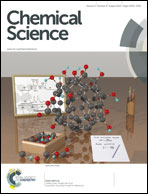Bioinspired polydopamine nanospheres: a superquencher for fluorescence sensing of biomolecules†
Abstract
The strong fluorescence quenching ability towards a wide spectrum of fluorescent dyes of bioinspired polydopamine nanospheres was shown for the first time. Up to 97% quenching efficiency via energy transfer and/or electron transfer was obtained towards four kinds of fluorophores, aminomethylcoumarin acetate (AMCA), 6-carboxyfluorescein (FAM), 6-carboxytetramethylrhodamine (TAMRA) and Cy5. This fluorescence quenching ability compared favorably with that of graphene oxide, the superquencher. The nanospheres (NS) also exhibit different affinities for various ssDNA conformations. Furthermore, FAM-labeled ssDNA was adsorbed onto NS through non-covalent binding to form an ssDNA/NS complex, leading to the quenching of the fluorescence of FAM. This complex was used as a sensing platform for the detection of DNA and proteins based on the fluorescence recovery due to target recognition. The LODs of DNA and thrombin were equal or close to those of GO-based biosensors. The assay is fast, simple and homogeneous, and could be used for fluorescence imaging. The excellent biocompatibility and biodegradability of polydopamine also render it suitable for in vivo applications.


 Please wait while we load your content...
Please wait while we load your content...